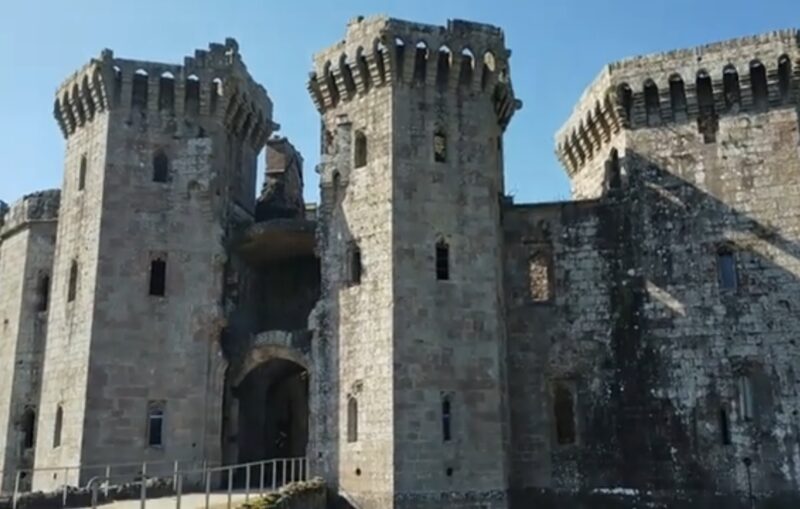Walking Through the Shadows of Raglan Castle
Unlike Caldicot Castle, with its Norman fortifications and intimate atmosphere (which I explored in my previous blog here). Raglan Castle feels altogether grander. As I approached its towering gatehouse, I was struck by the sheer scale of the ruin. Its majestic Tudor-style architecture, impressive moats, and sprawling courtyard hint at a past filled with wealth, power, and eventually, destruction. But where history lingers, so too do the whispers of Raglan Castle ghost stories. Many believe that the spirits of its noble residents and fallen soldiers still wander the halls. Rapped in a place that once stood as a symbol of power and prestige.
Would I experience anything unusual, or would these ghostly tales remain just that—stories passed down through the ages?
The Ghost of the Last Marquis
Perhaps the most famous of Raglan Castle ghost stories is the spirit of the last Marquis of Worcester. Who is said to haunt the ruins to this day. During the English Civil War, the castle was besieged by Parliamentarian forces, and its proud owner, Henry Somerset, 1st Marquis of Worcester, was forced to surrender. He was taken prisoner, and his once-glorious home was left in ruins.
Legend has it that his restless spirit still walks the castle, mourning its destruction and the loss of his family’s legacy. Visitors have reported seeing a shadowy figure in fine clothing, pacing near the Great Tower. Others describe an overwhelming feeling of sadness when standing within the ruins.
Could this be the Marquis himself, forever bound to the place he so desperately tried to protect? Or is it simply the weight of history creating an eerie atmosphere?
Mysterious Sounds in the Great Hall
The Great Hall of Raglan Castle was once the heart of noble life—hosting grand feasts, political meetings, and celebrations. Today, it lies open to the elements, but some say not all of its former residents have left.
Visitors have reported hearing whispers, the faint sound of music, and even echoes of footsteps, as if the castle’s grandest days were still playing out in another realm. Could these be residual echoes of the past, or is there something more lingering within these ancient walls?
The Grey Lady of Raglan
Like many historic castles, Raglan Castle has its own “Grey Lady”, a spectral figure often seen drifting along the castle corridors. Unlike the Green Lady of Caerphilly or the White Lady of Caldicot, this ghost is often associated with sorrow and regret.
Some believe she was a noblewoman who lost a loved one during the Civil War, forever mourning the destruction that followed. Others think she may have been a servant or caretaker, forever tied to the castle she once called home.
Sightings of a shadowy female figure are most common near the castle towers, particularly at dusk when the ruins take on an eerie, ghostly glow.
Historical Figure: Henry Somerset, 1st Marquis of Worcester
One of the most influential figures in Raglan Castle’s history is Henry Somerset, 1st Marquis of Worcester. A staunch Royalist, he was a key supporter of King Charles I during the English Civil War. Under his leadership, Raglan Castle became one of the last Royalist strongholds in Wales, until it was besieged and ultimately fell to Parliamentarian forces in 1646.
After surrendering, Somerset was imprisoned, and his beloved castle was left in ruins as a warning to others who opposed Parliament. Given his deep attachment to Raglan, it’s not surprising that some believe his spirit still lingers, refusing to abandon the place he fought so hard to protect.
Where to Next?
Leaving Raglan Castle, I couldn’t help but feel that this place holds onto its past more than most. Unlike Caldicot’s quiet ghostly whispers, Raglan’s history feels loud, tragic, and unshakable, as if the ruins themselves refuse to be forgotten.
But the journey isn’t over yet. Next, I visit Chepstow Castle, one of the oldest stone-built fortresses in Britain, standing as a guardian over the River Wye. Unlike Raglan’s Tudor elegance, Chepstow is a fortress in the truest sense—its walls have withstood centuries of battle, rebellion, and change. Will its ghost stories prove as formidable as its defenses?
I’m about to find out.
Disclaimer
While Raglan Castle has a rich history of ghost stories, all paranormal claims should be viewed with a critical mind. Many sightings can be explained by psychology, environmental factors, and historical context. This blog explores these stories from both a historical and skeptical perspective.
Call to Action
Love reading about Welsh castles and their ghost stories? Share this blog on social media and let others join the discussion!
Want to explore more haunted locations and historical sites? Visit my website: brianwelsh500.com for more blogs, photos, and castle guides!



